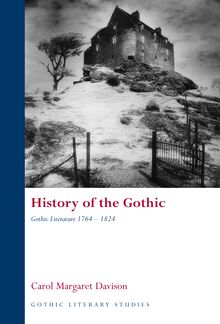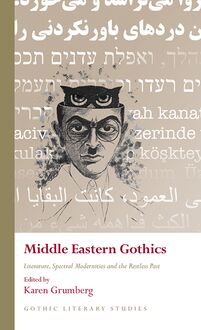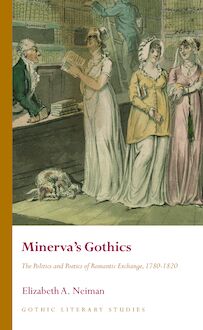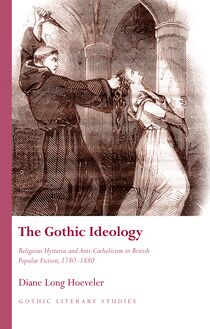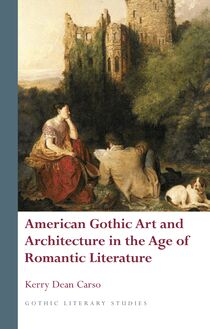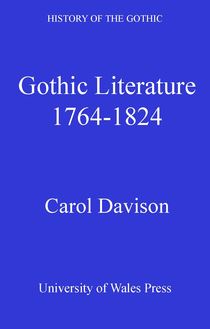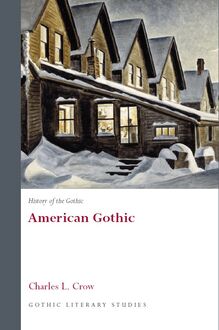Gothic Invasions , livre ebook
158
pages
English
Ebooks
2018
Vous pourrez modifier la taille du texte de cet ouvrage
Obtenez un accès à la bibliothèque pour le consulter en ligne En savoir plus
Découvre YouScribe et accède à tout notre catalogue !
Découvre YouScribe et accède à tout notre catalogue !
158
pages
English
Ebooks
2018
Vous pourrez modifier la taille du texte de cet ouvrage
Obtenez un accès à la bibliothèque pour le consulter en ligne En savoir plus
Publié par
Date de parution
28 mars 2018
Nombre de lectures
5
EAN13
9781786832115
Langue
English
Poids de l'ouvrage
1 Mo
What do tales of stalking vampires, restless Egyptian mummies, foreign master criminals, barbarian Eastern hordes and stomping Prussian soldiers have in common? As Gothic Invasions explains, they may all be seen as instances of invasion fiction, a paranoid fin-de-siècle popular literary phenomenon that responded to prevalent societal fears of the invasion of Britain by an array of hostile foreign forces in the period before the First World War. Gothic Invasions traces the roots of invasion anxiety to concerns about the downside of Britain’s continuing imperial expansion: fears of growing inter-European rivalry and colonial wars and rebellion. It explores how these fears circulated across the British empire and were expressed in fictional narratives drawing strongly upon and reciprocally transforming the conventions and themes of gothic writing. Gothic Invasions enhances our understanding of the interchange between popular culture and politics at this crucial historical juncture, and demonstrates the instrumentality of the ever-versatile and politically-charged gothic mode in this process.
Acknowledgements
List of Illustrations
Introduction: The Call to Arms
Section I: Gothic Fictions of Empire
Chapter 1: Gothic Invasions from the East and West Indies: Vampires, Mesmerists and Other Demons
Chapter 2: Gothic Invasions from Egypt: Mummies and Curses
Section II: Genre and Gothic Invasion
Chapter 3: Crime Fiction: Mephistophelean Master Criminals
Chapter 4: Yellow Peril Fiction: Villainous Celestials
Chapter 5: Military Invasion Tales: Brutish Europeans and Gothic Battlefields
Afterword: ‘To Arms!’ in Earnest
Select Bibliography
Index
Publié par
Date de parution
28 mars 2018
EAN13
9781786832115
Langue
English
Poids de l'ouvrage
1 Mo
GOTHIC INVASIONS
SERIES PREFACE
Gothic Literary Studies is dedicated to publishing groundbreaking scholarship on Gothic in literature and film. The Gothic, which has been subjected to a variety of critical and theoretical approaches, is a form which plays an important role in our understanding of literary, intellectual and cultural histories. The series seeks to promote challenging and innovative approaches to Gothic which question any aspect of the Gothic tradition or perceived critical orthodoxy. Volumes in the series explore how issues such as gender, religion, nation and sexuality have shaped our view of the Gothic tradition. Both academically rigorous and informed by the latest developments in critical theory, the series provides an important focus for scholarly developments in Gothic studies, literary studies, cultural studies and critical theory. The series will be of interest to students of all levels and to scholars and teachers of the Gothic and literary and cultural histories.
SERIES EDITORS
Andrew Smith, University of Sheffield
Benjamin F. Fisher, University of Mississippi
EDITORIAL BOARD
Kent Ljungquist, Worcester Polytechnic Institute Massachusetts
Richard Fusco, St Joseph’s University, Philadelphia
David Punter, University of Bristol
Chris Baldick, University of London
Angela Wright, University of Sheffield
Jerrold E. Hogle, University of Arizona
For all titles in the Gothic Literary Studies series please visit www.uwp.co.uk
Gothic Invasions: Imperialism, War and Fin-de-Siècle Popular Fiction
by Ailise Bulfin
© Ailise Bulfin, 2018
All rights reserved. No part of this book may be reproduced in any material form (including photocopying or storing it in any medium by electronic means and whether or not transiently or incidentally to some other use of this publication) without the written permission of the copyright owner. Applications for the copyright owner’s written permission to reproduce any part of this publication should be addressed to the University of Wales Press, 10 Columbus Walk, Brigantine Place, Cardiff CF10 4UP.
www.uwp.co.uk
British Library Cataloguing-in-Publication Data
A catalogue record for this book is available from the British Library.
ISBN 978-1-78683-209-2
e-ISBN 978-1-78683-211-5
The right of Ailise Bulfin to be identified as author of this work has been asserted in accordance with sections 77 and 79 of the Copyright, Designs and Patents Act 1988.
The publisher has no responsibility for the persistence or accuracy of URLs for any external or third-party internet websites referred to in this book, and does not guarantee that any content on such websites is, or will remain, accurate or appropriate.
Cover image: ‘Le Péril Jaune’ (The Yellow Peril), Le Grand Illustré , 29 May 1904, front cover. Mary Evans Picture Library.
C ONTENTS
Acknowledgements
List of Illustrations
Introduction: The Call to Arms
Part I: Gothic Fictions of Empire
1 Gothic Invasions from the East and West Indies: Vampires, Mesmerists and Demons
2 Gothic Invasions from Egypt: Mummies and Curses
Part II: Genre and Gothic Invasion
3 Crime Fiction: Mephistophelean Master Criminals
4 Yellow-Peril Fiction: Villainous Celestials
5 Military Invasion Tales: Brutish Europeans and Gothic Battlefields
Afterword: ‘To Arms!’ in Earnest
Notes
Select Bibliography
A CKNOWLEDGEMENTS
Writing a book is by no means an individual effort, and for me has been enabled by the considerable and generous support of a number of people whom I would very much like to thank here. Darryl Jones’s expertise in the dark side of the literary imagination has been inspirational on the project from the start and his support and advice have been invaluable throughout. I would also like to thank all the following people for productive conversations, insightful feedback and opportunities to present the work: Dara Downey, Douglas Kerr, Julia Kuehn, Roger Luckhurst, Victoria Margree, Bernice Murphy, Meg Tasker, Kim Wagner and Minna Vuohelainen. I must also thank the members of the Invasion Network research group (as we decided to call ourselves without realising the possible irony of the title) for sharing their wealth of historical knowledge and providing a tremendous forum for sounding out new invasion-related ideas – especially Brett Holman, Michael Hughes, Michael Matin, Richard Scully, Antony Taylor and Harry Wood. I am indebted to the Shielians for their generosity in sharing their knowledge, most particularly John D. Squires, whose passing has left the group sadly depleted. Many thanks also are due to my editors at University of Wales Press – to Andrew Smith for encouraging me to submit and to Sarah Lewis for guiding me through the process. Most of the work was carried out at the Trinity Long Room Hub, Arts and Humanities Research Institute of Trinity College Dublin, and I would like to thank the staff and my fellow residents for their support and for providing such a stimulating environment throughout. I would also like to thank the Department of English at the National University of Ireland Maynooth for providing a very supportive environment in which to complete the book.
Many thanks are also due to the staff in various libraries, particularly Simon Lang and all the staff in the Early Printed Books room of Trinity College Library; also the British Library, the British National Army Museum, the Richmond Local Studies Library and the State Library of Victoria, Melbourne. I am grateful to all the individuals and organisations who provided me with copies of the images used and granted me permission to reproduce them. They are acknowledged individually beneath the images in each chapter.
I would also like to acknowledge that this project was largely funded by a Government of Ireland Postdoctoral Fellowship from the Irish Research Council, without which it would not have been possible. It also benefited from a Royal Irish Academy Charlemont Scholarship and Popular Culture Association award which facilitated travel to archives and conferences.
My deepest gratitude is due to the family and friends who have kept me going throughout, most especially my husband Liam, my parents Antoinette and Mike, and my three children Siofra, Morgan and Emmett. This would not have been possible without you all – and it is dedicated to you.
Some of the material here has been previously published in partial form: chapter 2 is an expanded version of an article first published in English Literature in Transition , 54/4 (2011); parts of chapter 3 derive from a chapter in Mandy Treagus et al. (eds), Changing the Victorian Subject (Adelaide: University of Adelaide Press, 2014); and parts of chapter 4 derive from an article in Julia Kuehn (ed.), Australasian Journal of Victorian Studies , The Victorians and China, 20/1 (2015).
L IST OF I LLUSTRATIONS
Colour Plates
I. ‘The Battle of Isandlwana, 22 January 1879.’ Oil on canvas by Charles Edwin Fripp, 1885.
II. Front cover detail of Doctor Nikola (London: Ward, Lock & Co., 1896).
III. Cover of the second edition of The Yellow Danger (London: Grant Richards, 1900).
IV. Hodder & Stoughton 1944 ‘yellow jacket’ edition of John Buchan, The Thirty-Nine Steps (1915).
Figures
Introduction
Figure 1. ‘History Repeats Itself. ( Scene in a London Restaurant. ) “Nero fiddled while Rome was burning.”’ The Windsor Magazine , 1 (May 1895), 480.
Chapter 1
Figure 1. ‘The Fighting on the Indian Frontier: With the Tirah Field Force’, Supplement to The Graphic , 18 December 1897, 1.
Figure 2. Cover illustration, The Mystery of Cloomber (London: Ward & Downey, 1888).
Figure 3. ‘As silently and rapidly as one of his native snakes.’ ‘Uncle Jeremy’s Household’, The Boy’s Own Paper , 9 (February 1887), 329.
Chapter 2
Figure 1. ‘“Hold on!”: “An allegory on the banks of the Nile” – Mrs. Malaprop’. Punch , 82 (10 June 1882), 271.
Figure 2. ‘So distorted was his countenance that I instinctively recoiled from him in horror.’ Pharos the Egyptian (London: Ward, Lock & Co., 1899), p. 56.
Figure 3. ‘Government Hospitality.’ Punch , 53 (13 July 1867), 15.
Figure 4. ‘A “Capital” Sentence!’ Punch , 83 (16 December 1882), 282.
Figure 5. ‘“Drink”, he said.’ Pharos the Egyptian (London: Ward, Lock & Co., 1899), p. 180.
Figure 6. ‘The Egyptian Question.’ Punch , 110 (28 March 1896), 161.
Chapter 3
Figure 1. Dr Nikola in his laboratory in Port Said. Frontispiece to A Bid for Fortune (London: Ward, Lock and Bowden, 1895).
Figure 2. ‘He turned his rounded back upon me.’ ‘The Final Problem’, Strand Magazine , 6 (December 1893), 563.
Figure 3. ‘I walked right into six of them’, ‘The Crooked Man’, Strand Magazine , 6 (July 1893), 31.
Figure 4. ‘As It May Be: A Forecast’, The Bulletin , 12 October 1901, 22.
Figure 5. ‘After the first cut the wretched culprit no longer attempted to comport himself like a man.’ The Beautiful White Devil , The African Review , 6 (9 November 1895), 810.
Chapter 4
Figure 1. ‘Enraged Coolie.’ ‘A Chapter on the Coolie Trade’, Harper’s New Monthly Magazine , 29 (June 1864), 2.
Figure 2. ‘The Work of Civilisation.’ Punch , 107 (11 August 1894), 62.
Figure 3. ‘The Assassin.’ Doctor Nikola (London: Ward, Lock & Co., 1896), 97.
Figure 4. ‘To my amazement he was a Chinaman.’ Dr Nikola’s Experiment (London: Hodder & Stoughton, 1899), p. 144.
Figure 5. ‘The scream of the victim and the scream of his slayer.’ The Empress of the Earth , Short Stories , 4 (21 May 1898), p. 657.
Chapter 5
Figure 1. Cover of William Le Queux, The Great War in England in 1897 (London: Tower, 1894).
Figure 2. Frontispiece to George Griffith, In an Unknown Prison Land: An Account of Convicts and Colonists in New Caledonia (London: Hutchinson, 1901).
Figure 3. ‘Lord Roberts Warns You’, advertisement for The Invasion of 1910 , The Athenaeum , 21 July 1906, 60.
Figure 4. Destruction of New York, H. G. Wells, The War in the Air (London: Bell, 1908), [208].


